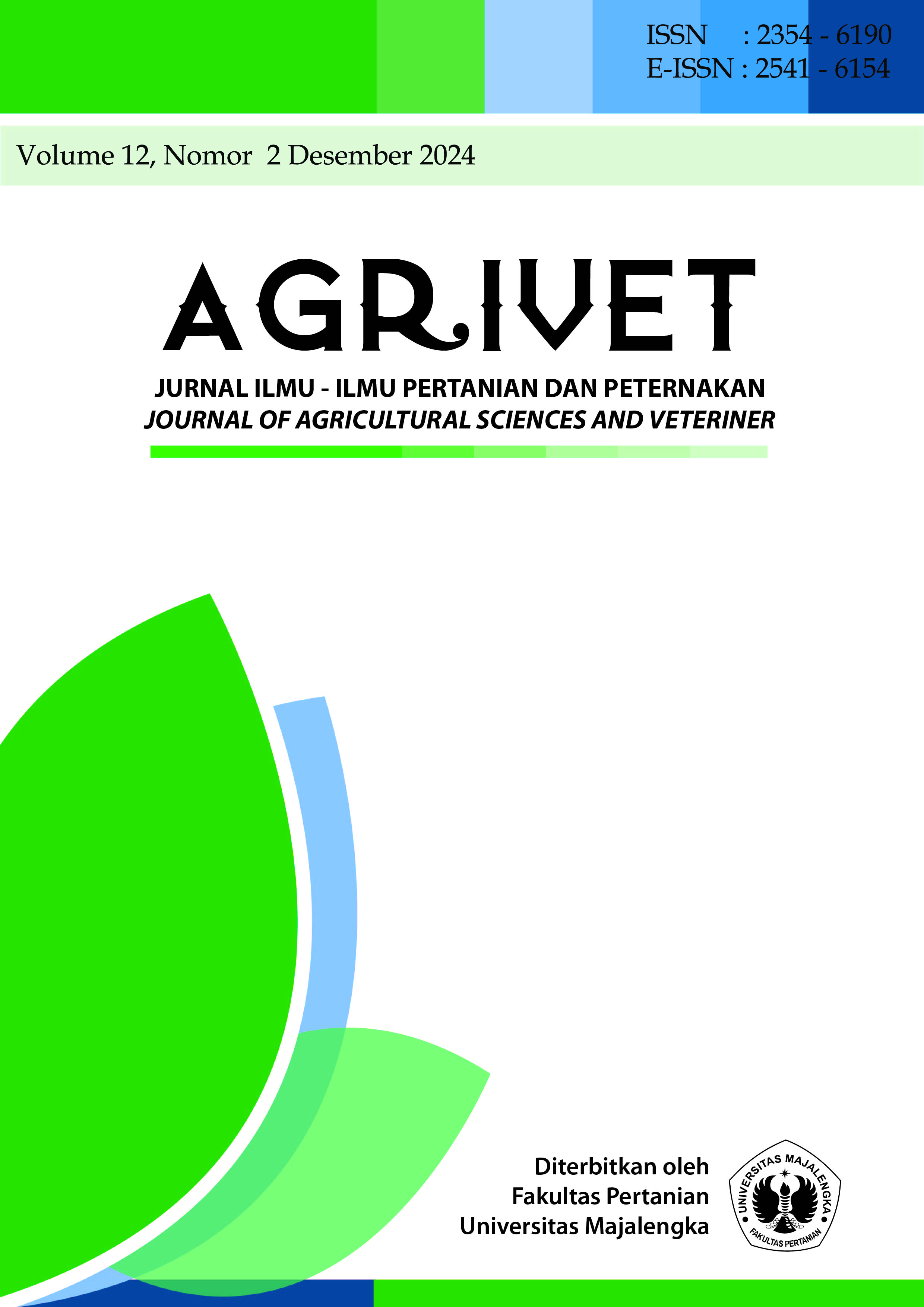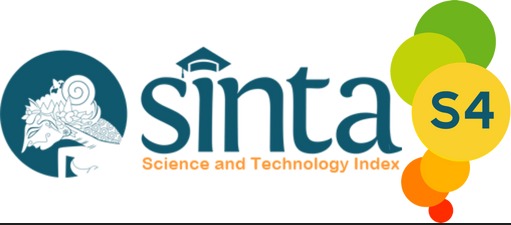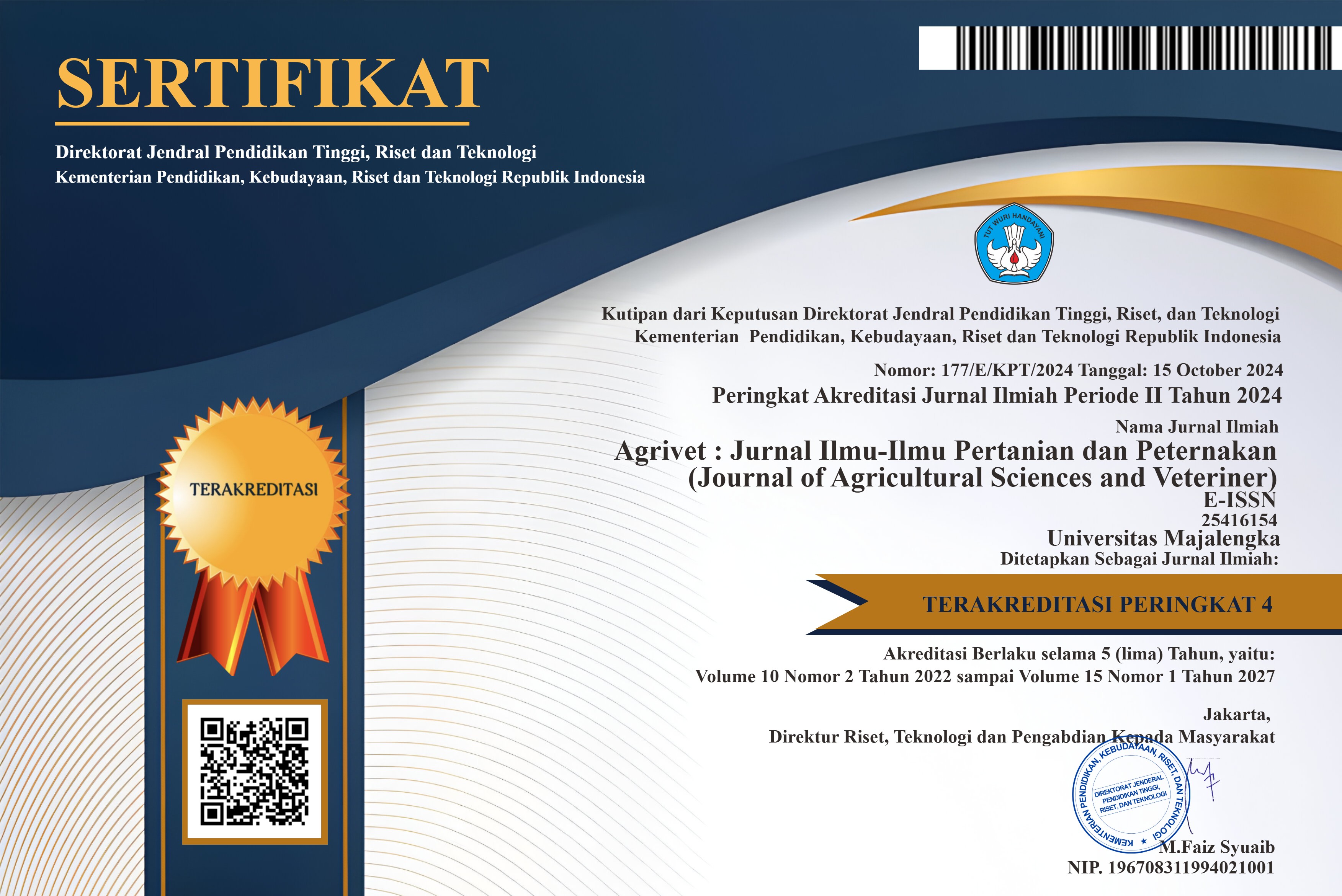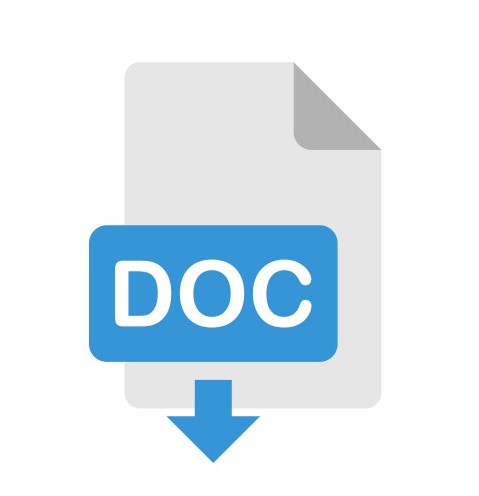Effect of adding sawdust and husk ash on N, P, K and C-organic content in making goat manure compost
DOI:
https://doi.org/10.31949/agrivet.v12i2.11139Abstract
This research aims to determine the effect of adding sawdust and husk ash on the N, P, K and C-Organic content in making goat manure compost. Materials used in making compost include: sawdust, husk ash, goat manure, EM4, water and palm sugar. This research was conducted using the Completely Randomized Design (CRD) method consisting of 5 treatments and 4 replications. The percentage ratio of goat manure, sawdust, and husk ash used in each treatment is A (100:0), B (75:25), C (75:25), D (75:12.5:12.5) and E (50:25:25). The variables observed were levels of N, P, K, and C-Organic. The data obtained were analyzed using the F test, followed by Duncan's Multiple Range Test (DMRT) with a 95% confident level. The result shows that the addition of sawdust and husk ash to composting goat manure had no significant effect (p>0.05) on the N, P and K content, but had a significant effect (p<0.05) on organic C. It can be concluded that Compost with the addition of sawdust and husk ash in compost has no significant effect (p>0.05) on the N, P, and K content but has a significant effect (p<0.05) on the organic C. Based on the results of research that has been carried out regarding the addition of sawdust and husk ash to making goat manure compost, it was found that the chemical parameters of the compost in the form of Nitrogen, Phosphorus, Potassium, and C-organic are by SNI 19-7030-2024.
Keywords:
compost, nitrogen, phosphorus, potassium, C-organicDownloads
References
Alif, S.M. 2017. Kiat sukses budaya cabay rawit. Yogyakarta: Bio Genesis
Anang, 2010. Teknik pembuatan kompos. Kabupaten sukomoro : Kalimantan tengah.
Ayu, N, 2022. Pengomposan Sampah Kulit Nanas, Kotoran Ayam, dan Kotoran Sapi Menggunakan Larva Black Soldier Fly (BSF). Politeknik Perkapalan Negeri Surabaya. Surabaya.
Ayu, S. D. 2019. Pengaruh Berbagai Kotoran Ternak Terhadap Proses Pengomposan dan Kualitas Kompos Dari Sabut Kelapa. Fakultas Pertanian. Universitas Brawijaya. Malang.
Badan Standarisasi Nasional. 2010. SNI 2803:2010. Pupuk NPK
Badan Litbang Pertanian, 2011. Inovasi pengelolahan singkong sesuai kadar tanah dalam pengomposan dapat meningkatkan pendapatan dan deversivikasi pangan.Jakarta: Argo Inovasi
Barus.2011. Uji Efektivitas Kompos Jerami dan Pupuk NPK terhadap Hasil Padi (Oryza sativa L) di Lampung. Jurnal Agrivigor 10 (3) : 250 – 255.
Boga, C., Del Vecchio, E., Forlani, L., dan Franceschetti, M. 2014. Microbes to clean indoor pollutants. Environmental Chemistry Letters, 12(3), 429–434.
Dewi, Y.S. dan Treesnowati. 2012. Pengolahan sampah skala rumah tangga menggunakan metode composting. Jurnal Ilmiah Fakultas Teknik LIMIT’S. 8(2):35-48.
Jamaludin. 2020. Pembuatan Pupuk Organik Guano Kelelawar. CV jejak : Jawa Barat
Manuputty, M. C., A. Jacob dan J.P. Haumahu, 2012. Pengaruh Effective Inoculant Promi Dan EM4 terhadap laju dekomposisi dan kualitas kompos dari sampah Kota Ambon. Agrologia Jurnal Ilmu Budidaya Tanaman, Vol. 1, (2). 143-151 (Oktober 2012), ISSN 2301-7287.
Mulyani, H. 2014. Buku ajaran kajian teori dan aplikasi optimasi perancangan model pengomposan. Jakarta;CV. Trans info media.
Mulyono. 2016. Membuat MOL dan kompos dari sampah rumah tangga. PT AgroMedia Pustaka : Jakarta Selatan
Murbandono, L. 2010. Membuat kompos edisi revisi. Penebar swadaya, Jakarta.
Muyassir, Sufardi, dan Saputra, I. 2012. Perubahan sifat fisika Inceptisol akibat perbedaan jenis dan dosis pupuk organik. Lentera 12 (1): 1-8.
Nurhayati, Sopiana, Kurniawan. T., Susanto. A dan Panduwinata. S. 2024. Kualitas Kandungan Unsur Hara Kompos Kotoran Kelelawar Dengan Penambahan Sampah Organik. Jurnal Agro Plantation. Vol. 3 (1). e-ISSN.2830-7097.
Novitasari, D., dan Caroline, J. 2021. Kajian Efektifitas Pupuk dari Berbagai Kotoran Sapi, Kambing dan Ayam. Seminar Teknologi Perencanaan, Perancangan, Lingkungan, Dan Infrastruktur II, 2003, 442–447.
Peraturan Menteri Pertanian No. 70/Permentan/SR.140/10/ 2011 Tentang pupuk organik, pupuk hayati, dan pembenah tanah.
Pereira, da S.A., B.L. Carlos., F.J. Cezar., R. Ralisch., M. Hungria., and G.M. De Fatima, 2014. Soil Structure and Its Influence On Microbial Biomass In Different Soil and Crop Management Systems. Soil & Tillage Research, Vol. 142, pp. 42–53.
Samsul, F. R. Dadi, 2010. Beternak dan Bisnis Sapi Potong. PT AgroMedia Pustaka : jakarta
Setiawan, A, I. 2007. Memanfaatkan kotoran ternak. Niaga Swadaya : Jakarta
Siboro, E., Surya, E., USU, N. H.-J. T. K., & 2013, undefined. (2013). Pembuatan pupuk cair dan biogas dari campuran limbah sayuran. Talenta.Usu.Ac.Id, 2(3). 40-43
Sriharti dan Salim, T. 2010. Pemanfaatan sampah taman (rumput-rumput) untuk pembuatan kompos. Prosiding Seminar Nasional Teknik Kimia “Kejuangan” Yogyakarta,
Tamtomo, F. S. Agus Suyanto, 2015. Pengaruh aplikasi kompos jerami dan abu sekam padi terhadap produksi dan kadar pati ubi jalar. 12(2): 1-7.
Trivana, L.Y. Pradhana dan A. P. Manambangtua, 2017. Optimalisasi waktu pengomposan pupuk kandang dari kotoran kambing dan debus abut kelapa dengan bioaktivator EM4. Jurnal Sains dan Teknologi Lingkungan Vol. 9 (1): 16-24
Vebriyanti, E.Il. Arief, Saluadih, P. Dewi. 2022. Karakteristik mikroorganisme, pH dan Unsur hara urine sapi perah di daerah Bogor, Jawa Barat. Jurnal Agripet, Vol 22 (2): 133-140.
Wahyu, Alifan AR. 2018. Pembuatan kompos senergi dengan bahan baku kotoran kambing, sekam dan serbuk gergaji di desa Karangmojo, Magetan. Prodi kesehatan masyarakat STIKes Bhakti Husada Mulia Madiun.
Widarti, B, N. Wardini, W, K. dan Sarwono, E. 2015. Pengaruh Rasio C/N Bahan Baku Pada Pembuatan Kompos Dari Kubis Dan Kulit Pisang. Jurnal Integrasi. 5(2):78-79
Yuniwati. 2012. Optimasi kondisi proses pembuatan kompos dari sampah organik dengan cara fermentasi menggunakan EM4. Jurnal Teknologi.5(2): 172-181
Published
How to Cite
Issue
Section
License
Copyright (c) 2024 Ely Vebriyanti, Boni Qarahma, Deni Novia

This work is licensed under a Creative Commons Attribution-ShareAlike 4.0 International License.
An author who publishes in the Jurnal Agrivet agrees to the following terms:
- Author retains the copyright and grants the journal the right of first publication of the work simultaneously licensed under the Creative Commons Attribution-ShareAlike 4.0 License that allows others to share the work with an acknowledgment of the work's authorship and initial publication in this journal
- The author is able to enter into separate, additional contractual arrangements for the non-exclusive distribution of the journal's published version of the work (e.g., post it to an institutional repository or publish it in a book) with the acknowledgment of its initial publication in this journal.
- The author is permitted and encouraged to post his/her work online (e.g., in institutional repositories or on their website) prior to and during the submission process, as it can lead to productive exchanges, as well as earlier and greater citation of the published work












